Berry Pomeroy Revisited
Perhaps there is such a thing as the perfect photographer: someone who with an unswerving eye for detail and a golden touch is able to capture brilliance every time she or her pushes the shutter.
For the rest of us it's different. As mere mortals, we strive not to make the same mistakes and be the best we can possibly be. And sometimes we have to change our way of thinking and simply adapt to circumstances we could not have possibly foreseen.
The recent rain is a case in point. How many times have our plans been altered because the wet stuff has fallen from the sky in all its forms; be it murky drizzle, a steady, rhythmic patter or an unrelenting torrential downpour? And yet (coming back to photography once more) there are ways to turn what initially seems a setback to your advantage. Everything sparkles in the rain. Pearly dewdrops and silvery orbs grace the stems and flowers of grasses, and every plant you pass appears bedecked in jewels.
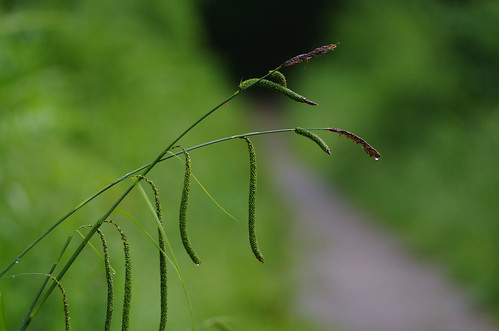
Pendulous Sedge (Carex pendula)
That's pendulous as in pendulum. The various definitions in my dictionary include swinging, hanging loosely, drooping and dangling. I would like to know what went through William Hudson's mind when discovering and naming this species. Did 'pendulous' just pop into his head or did he scour the dictionary until finding a word with both a relevant meaning and a satisfactory ring to it?

Unknown grass species
When the flowers (or spikelets, as they are termed in my guidebook) are covered in dew, another identification headache ensues. At home, magnified on the screen, I managed to narrow the grass above down to three species: Wood Millet, Wood Fescue and Wood Meadow Grass. But in the end I gave up and decided to move on.
Out in the field, the damp conditions were creating new opportunities. On a sunny day, you would be hard-pressed to get a clear shot of many butterflies because they are always on the move; either creating loops and shapes in the skies with their impressive aerial courtship displays or frenziedly feeding from flower to flower. We saw a Green-veined White rest on an umbellifer, and, as Sherry approached cautiously, I tiptoed ahead with Lady on the lead. We all know from experience what happens when you get too close and try to be quiet. There is usually a damp twig on the ground that surprises you with a snap or crack, and voila! the subject has gone.
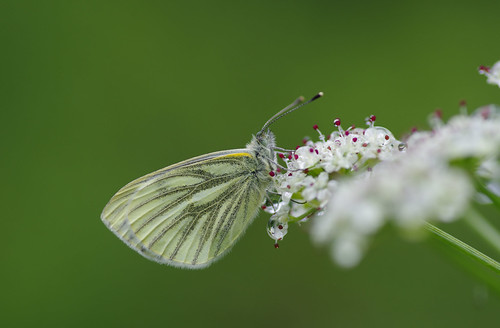
Green-veined White (Pieris napi)
It must have taken Sherry twenty or thirty attempts to get the butterfly into clear focus and get the composition she wanted. The one above has the former but too much blur in the right foreground. Nine times out of ten, if you let the subject get used to your presence, make no sudden movements and simply observe, then patience will be duly rewarded.
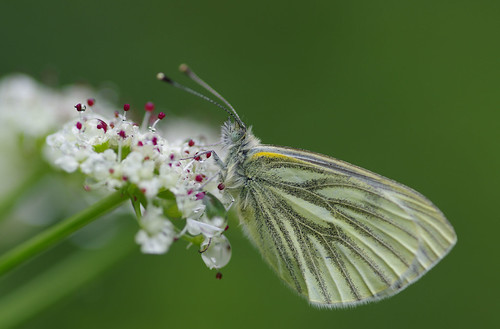
The best capture
Keeping the eye in focus can also create a connection between viewer and subject. The reflections off the umbellifer in some of the shots were too harsh and distracting; like staring at bare bulbs. But in the shot above, the tungsten effect has gone and the pearly dewdrops complement both the subject and the green background.
While Sherry waited to get to this point, making several rehearsals, Lady and I went ahead to do what we do best: scouting for new species. Sometimes I think we should have two cameras. In nature, there are always several spectacles happening at once and they don't stand on ceremony or wait for human spectators to take their places and be enthralled.
Then I remind myself that though I do have a good understanding of the basic principles of photography, when it comes to putting them into practice something tends to go awry. Perhaps one day I will be able to overcome this and a natural gift will develop. As an avid viewer of films, I have spent years learning about the visual language of cinema. Looking at moving images almost seems like second nature, while studying a still frame and creating what I would like to achieve feels a tall order. Maybe making short wildlife videos could be the best way forward. In the meantime, I am content to simply observe, learn and enjoy.

Yellow Dung-Fly (Scathophaga stercoraria)
Usually these flies are seen on fresh cowpats but they also must feed on flowers. This one seemed to be doing a little dance.
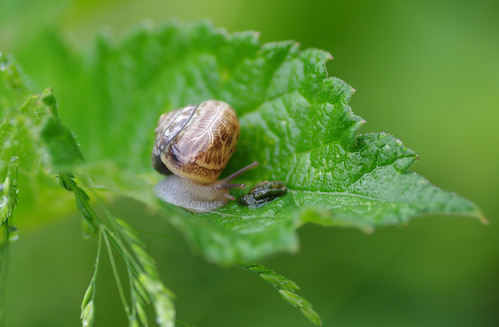
We were both struck by the unusual, almost translucent pattern on this snail's shell. It was on its way to making a meal of the unsavoury green blob to the right. This could have easily been airbrushed out in post-processing but then it would not accurately reflect what we saw. I think it's important to maintain a warts-and-all approach. By prettifying nature, we risk losing a large part of its vitality.
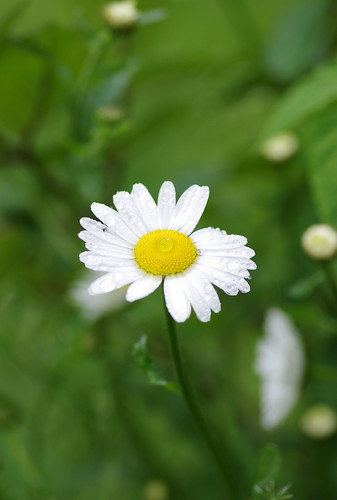
Oxeye Daisy (Leucanthemum vulgare)
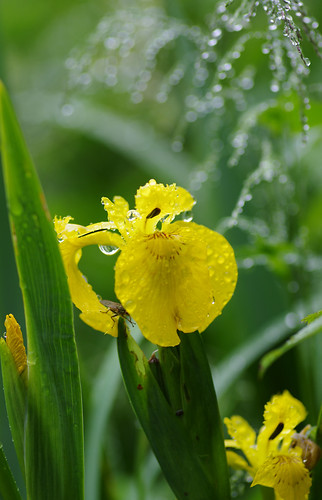
Yellow Iris (Iris pseudacorus)
Again, the rain has made this iris, and the grasses in the background, sparkle. It's a shame the head of the fly has been concealed by the flower but this is still an appealing shot. Yellow irises are commonly found at the margins of ponds and wet ditches.
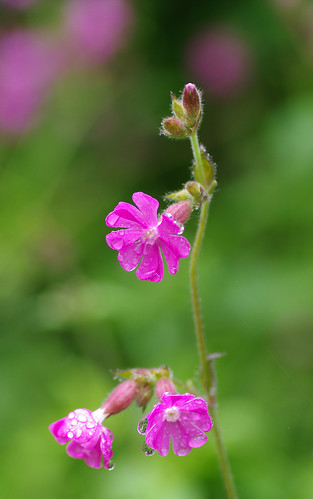
Red Campion (Silene dioica)
We see red campions practically everywhere among hedgerows and along lanes. They have a long flowering season but they have never come out as well as this before. The rain gives the colours that extra vibrancy.

Lichen on wooden post
My abiding memories of our walk near Berry Pomeroy Castle last year are being stung by a wasp and the more pleasurable experience of seeing lizards basking on short wooden posts. This year, it is too damp for the lizards and we reflected how much the lichen seemed to have grown.

Bastard Balm (Melittis melissophyllum)
This is a less common, more local flower. It is found near Buckfastleigh and the edges of Dartmoor but I have not seen it here before. This was the best example we saw - a bit past its best but great to see, nonetheless. There were several other specimens at the end of their season, with black spots on the leaves.
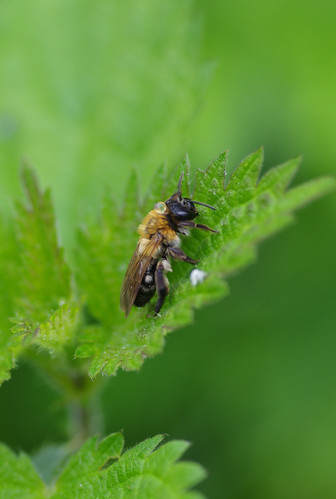
On the other side of the lane, we encountered a Comma caterpillar on a nettle leaf which did not quite come out, and this mining bee which did. These furry bees burrow holes in the ground. The one above looks most like the species Eucera Longicornis in my guide although the antennae look too short.
At length, we retraced our steps and ascended the lane near to the entrance of Berry Pomeroy Castle.
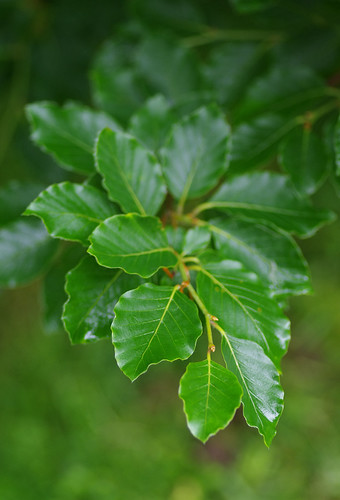
Leaves of the Beech tree (Fagus sylvatica)
This tree is also known as the 'Wishing Tree'. Berry Pomeroy Castle is steeped in sinister haunted tales of ghosts, entrapments and untimely deaths. As an old romantic ruin, the castle lends itself well to legend. Sherry likes to go there because the grounds and walls therein exercise a certain charm and give an unspoken attraction. They pull her towards the imagining the place as it was, at the height of its glorious heyday, before the centuries of decay and neglect. So, while Lady and I waited outside and watched the world and clouds go by, Sherry felt propelled by a sort of calling and went inside to forge connections with the past.
NOTE - Should you wish to follow our brief route, I would advise taking Ordnance Survey Map Explorer 110: Torquay and Dawlish.
We began near the Castle and went down the hill, then turned left along the lane before Afton Bridge, wandered along it a short distance and then retraced our steps. Even allowing for deviations, we probably walked less than a mile but it was a richly rewarding day in every sense.
For the more adventurous walker, there are many lanes in the area to explore. Following the level lane on to Gatcombe Mill and beyond is relatively easy, as it is a section of the John Musgrave Heritage Trail that links either end of Torbay, via Totnes in the middle. After heavy rain, the path through the woods can be extremely muddy so a stout pair of walking boots are required.

Comments
Add a Comment